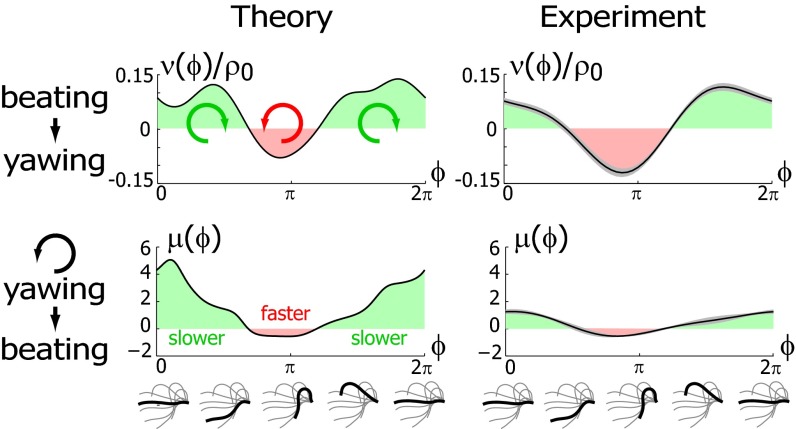Fig. 5.
Flagellar beating and cell-body yawing are coupled in a bidirectional way. (Upper Left) In our theory, the beat of the left flagellum generates a torque, which, in the absence of the right flagellum, has to be counterbalanced by a yawing motion of cell body (Eq. 4). This effect is quantified by the coupling function  shown, normalized here by
shown, normalized here by  : The effective stroke
: The effective stroke  of the left flagellum causes the cell to yaw clockwise. (Lower Left) Conversely, yawing of the cell changes the hydrodynamic friction force that opposes the flagellar beat, which, in our theory, speeds up or slows down the beat (Eq. 2). This effect is quantified by the coupling function
of the left flagellum causes the cell to yaw clockwise. (Lower Left) Conversely, yawing of the cell changes the hydrodynamic friction force that opposes the flagellar beat, which, in our theory, speeds up or slows down the beat (Eq. 2). This effect is quantified by the coupling function  shown: a counter-clockwise yawing during the effective stroke of the left flagellum slows down its beat. The coupling of beating and yawing allows for flagellar synchronization in a free-swimming cell. (Right) By fitting Eqs. 2 and 4 to experimental time-series data, we can recover the coupling functions
shown: a counter-clockwise yawing during the effective stroke of the left flagellum slows down its beat. The coupling of beating and yawing allows for flagellar synchronization in a free-swimming cell. (Right) By fitting Eqs. 2 and 4 to experimental time-series data, we can recover the coupling functions  and
and  (1 cell,
(1 cell,  time series of 0.5-s duration; gray regions denote mean ± SE).
time series of 0.5-s duration; gray regions denote mean ± SE).

